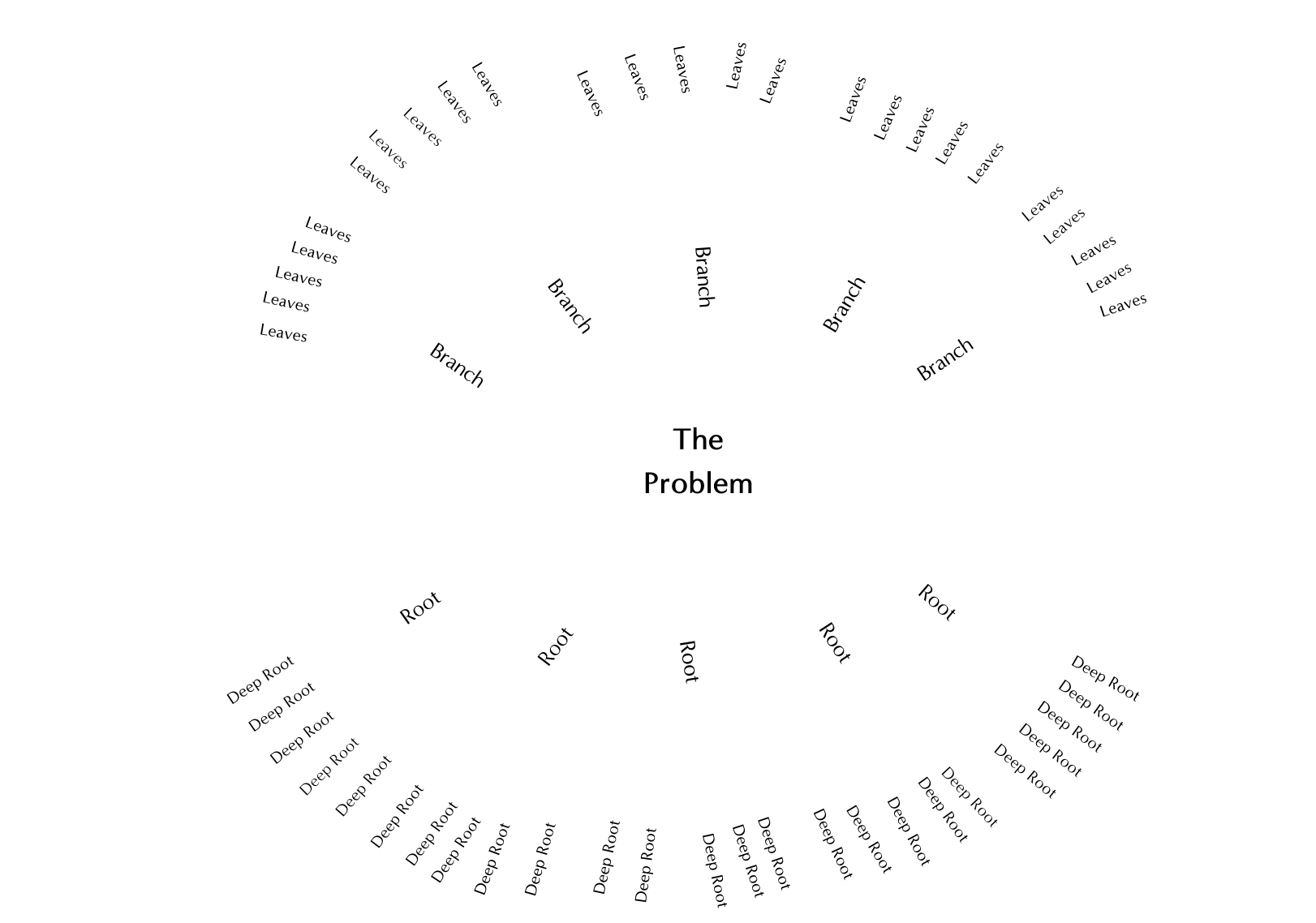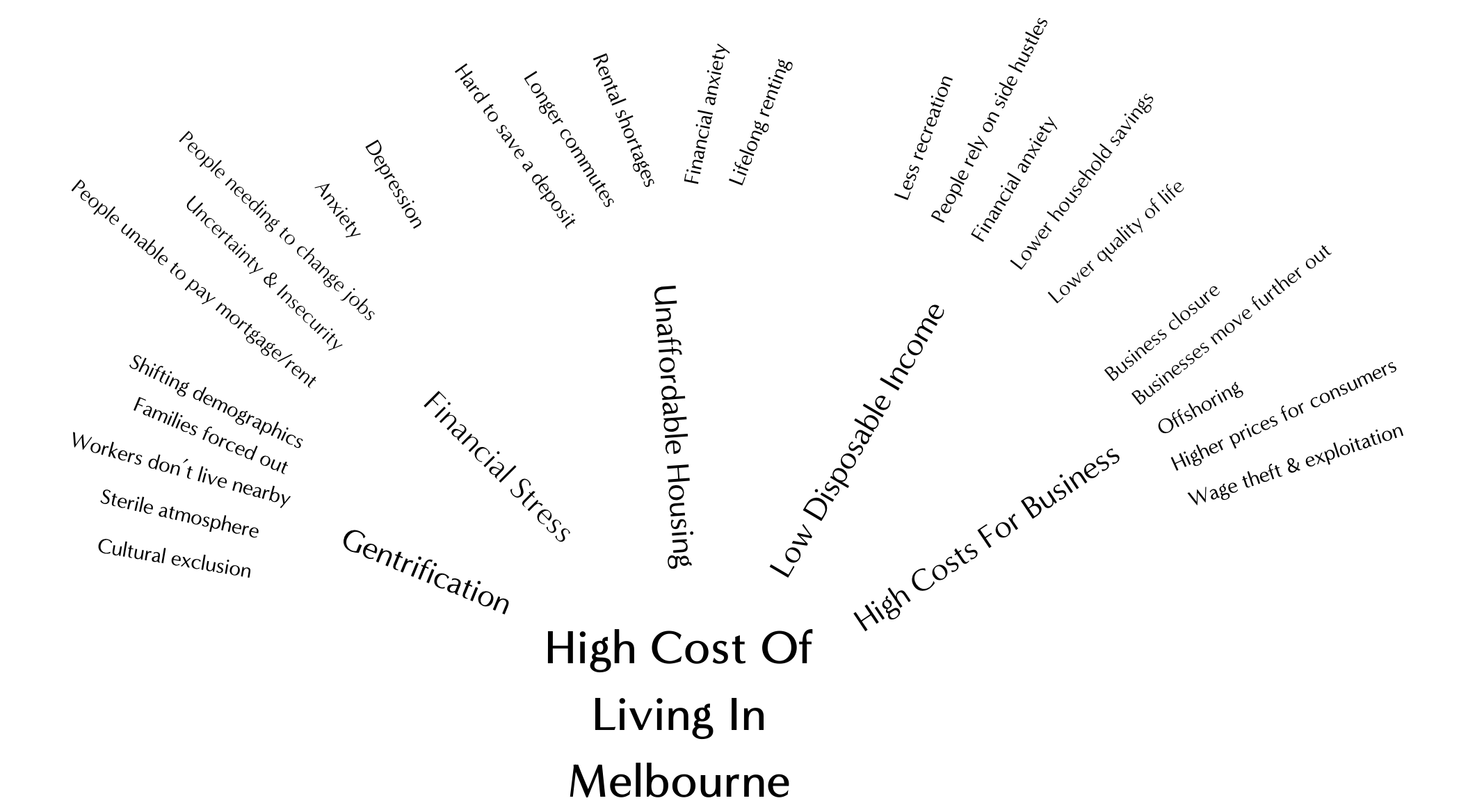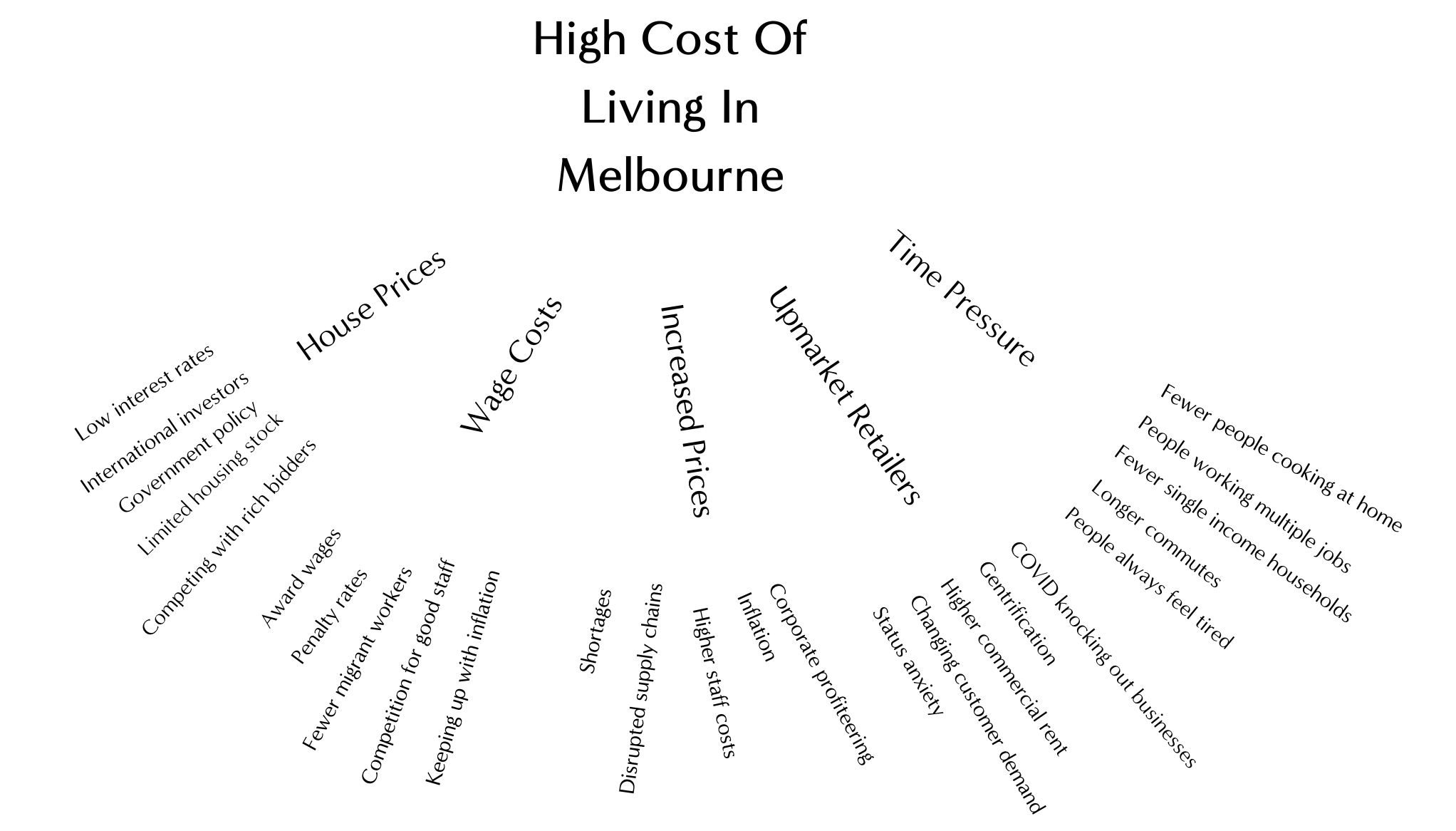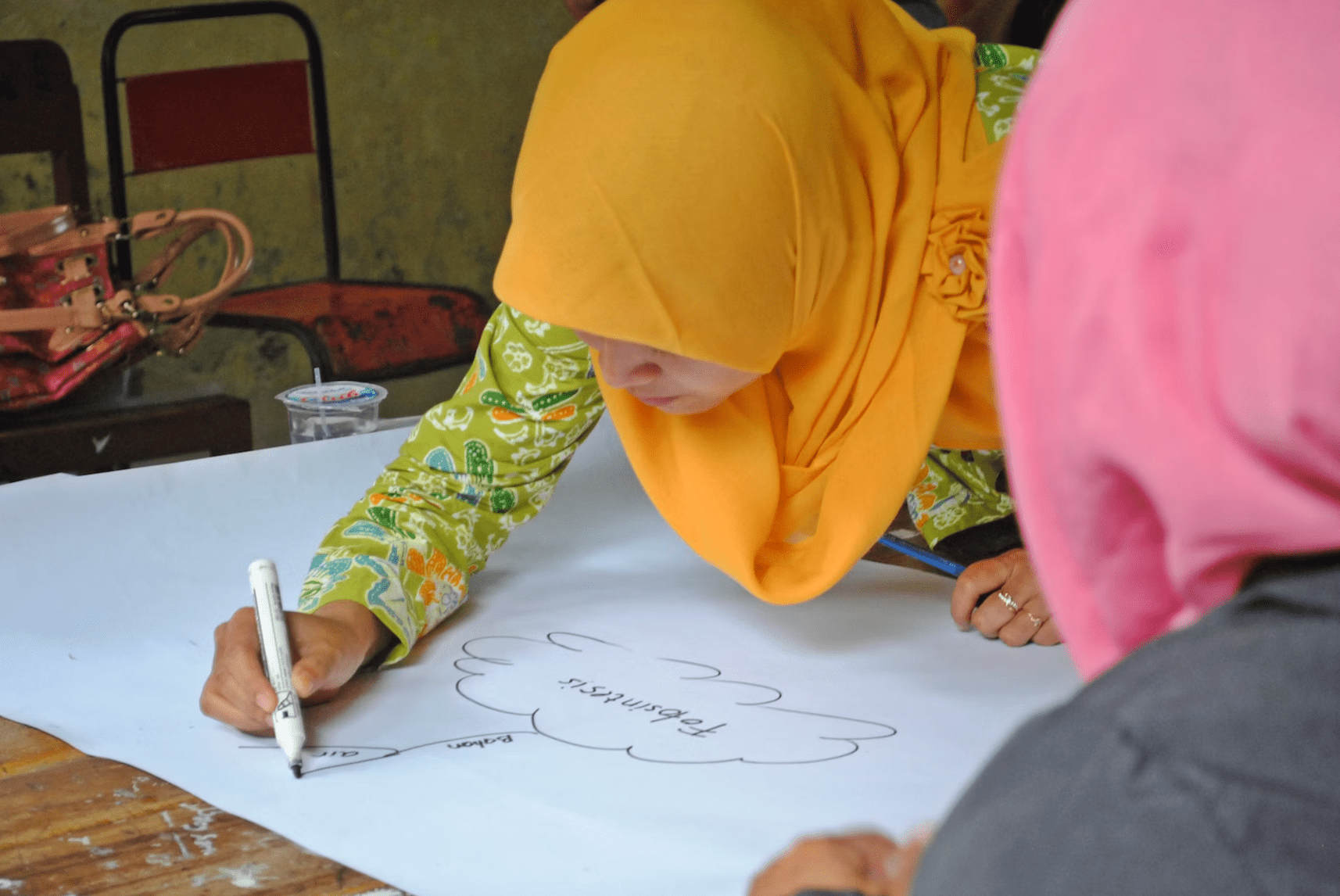The Problem Tree
Believe it or not, most people who start businesses aren’t primarily motivated by money.
Money is nice, money is helpful, but there are already plenty of professions that generate money without taking on entrepreneurial risk.
Instead, most founders are driven to try something new because of a dissatisfaction with what already exists.
We have a problem.
You can usually identify these problems by phrases like “why is it still so hard to…” or “how come no one has invented a…”.
Maybe there are things in the world that are flawed or inappropriate, or maybe there are gaps where there should be institutions or services that don’t exist today.
Either way, there’s a motivation to make something different, but it’s really hard to define what needs to change.
And if we don’t understand what we want to change, it’s going to be really hard to build a business that makes a real difference.
Rather than trying to start with the perfect solution, we want to get a true understanding of the problem – and problems can be hard to pin down.
There are three component to a problem, and they sort of resemble a tree:
The Trunk
In the middle is the tree trunk, the name of the problem.
Like a tree trunk, these problems are usually old, hard to move, and not overly complicated.
Here are some examples:
“There are more homeless people in our city than ever before”
“We still have issues with domestic abuse in families”
“Some regions are food deserts with little access to affordable healthy produce”
“Indigenous voices are missing from our boardrooms”
The Branches
But these problems have consequences; they lead to more issues that are visible and diverse.
That’s why we represent these as thick branches stemming out of the top of the trunk.
It’s helpful to aim for five big branches of these consequences, so that we understand the broad range of issues.
e.g. for the domestic abuse example, we might look at the consequences for;
· the person suffering the abuse
· for children in the household
· the cultural acceptance of abuse
· the effects on the justice system, etc.
Anyone with a lived experience of this issue will identify more branches, which is helpful in broadening our understanding of the problem.
That’s why you’ll want to consult knowledgeable people, they can see different parts of the tree.
For the Indigenous perspectives in boardrooms, we might look at the consequences for;
· governance & decision making
· the organisation’s culture
· their environmental impact
· their economic impact
· the alienation of Indigenous people, etc.
Each of those branches will send us to a different aspect of the issue, some of which we might not have thought about before brainstorming.
That’s ok, this is a great time to start.
The Leaves
Next, we want to explore the leaves at the ends of the branches; the consequences of the consequences.
For each branch, we ask ourselves “So what does that lead to?” or “How might this be visible?”, following the logic through to the end.
Make no mistake, these branches definitely have more consequences to them, and if you can’t think of them that doesn’t mean they don’t exist, it means you’re looking in the wrong spots or looking through the wrong lens.
For example, if we ask “what are the consequences affecting children in domestic abuse situations?”, we might see the effects on;
· their education
· their physical safety
· their mental health
· their friendships
· the risks of perpetuating harmful cycles in the future.
All of these are important, they’re all slightly different, and they’re evidence that this problem urgently needs well-designed solutions.
Another example might be “what are the effects on organisational culture from a lack of Indigenous perspectives in boardrooms?”, we might see the effects on;
· who gets hired
· how well staff are retained
· intentional and unintentional racism
· how the organisation is perceived in the wider community.
It’s worth noting at this point that these consequences are usually hard to read and unpleasant to think about.
Writing them at the top of the tree helps remind us of their significance, and why this tree needs to come down.
As unpleasant as they are, we also don’t want to shy away from the reality of the problem – people and committees tend to make cruel decisions when they don’t have to see the grim outcomes for themselves.
It can feel awkward and confronting to write about these topics, so please consider taking breaks and talking with good people to help process your thoughts.
The Roots
If a problem is like a tree, then pruning back the branches only offers us a limited and temporary benefit.
The tree will grow back.
We can try to address the symptoms and effects of the problem, but it’s the roots that are keeping the problem alive and strong.
If we want to actually address the problem, we need to attack the roots, and we’re going to need a co-ordinated effort with a lot of other people.
To model this out, we do exactly the same process as earlier, but for the underside of the tree.
What are the five main root causes of this problem?
What allows this problem to thrive?
What gives it fuel or space?
For example, we might see issues like;
· what gets funded
· who has the power
· what old habits are hard to shake
· whose voices are amplified
· what is tolerated
· what is legal
· where something is the only technical solution available.
For an example like “Why do we still use so many takeaway coffee cups?” we can look at root causes like;
· affordability
· habit
· hygiene
· social acceptability
· a lack of recyclable alternatives.
Next, we want to identify the five deeper roots that supporting each of those five main causes.
This is sometimes called the “nagging toddler approach”, where we keep asking “why?” again and again until we get to the heart of the matter (it usually takes 4-7 attempts).
For our takeaway coffee cup example, we might dig into hygiene and look at why it’s hard to hand over a dirty cup to a busy barista, or look at recyclability and see why today’s cups are destined for landfill.
This should leave us with around 25 deep root causes, a mirror image of the top of our tree.
What’s really interesting is that these 25 deep roots might seem similar or interconnected, but you’ll notice that they take different angles on the problem.
They each prompt a “How might we…” question, which doesn’t have a predetermined answer but sends you down a different path.
For example, “How might we make a recyclable takeaway cup liner?”, “How might we make reusable cups a status symbol?” and “How might we make takeaway cups harder to access?” will send you down very different paths, and will lead you towards three wildly different projects.
One is about new materials and their biodegradability, one is about fashion symbols and aesthetics, and one is about behaviour change techniques for limiting customer choices.
Generally speaking, most people have a natural gravitation to one of those options, perhaps based on their backgrounds, their strengths or their interests.
This is also why social enterprise needs a diversity of entrepreneurs and specialists, in this case, chemists, engineers, marketers, designers, policy makers and logistics experts.
All of their skillsets make contributions to making unrecyclable cups a relic of the past.
As a changemaker, you can’t possibly address all 25 deep roots of your Problem Tree – you’re going to need to choose a focus area for the next stage of your research.
A good way to start the refinement process is to pick a top 5 if you’re a solo founder, or invite each team member to pick a top 3, and discuss your chosen favourites.
You’re not choosing a business, you’re choosing a question to explore.
That’s all we need to close out this process – a few well-phrased questions for you to explore.
Worked Example
Let’s look at a real example: the cost of living in Melbourne, Australia.
It’s a constant topic of conversation, and has affected everyone in the city (albeit not evenly).
Here’s what we made in 30 minutes - imperfect but a good start.
Trunk: High Cost Of Living In Melbourne.
This was an easy starting point, although it’s a bit vague.
Branches: We listed five main consequences or effects (gentrification, financial stress, unaffordable housing, low disposable income, high costs for businesses).
We’re probably missing some branches, as these branches are the ones that affect people in our neighbourhood.
Leaves: These leaves are educated guesses and speculation, and could do with additional perspectives, but it’s a great starting point.
Roots: We listed five main root causes (house prices, wage costs, increased prices, upmarket retailers, time pressure).
Interestingly, these are mostly economic issues, and we haven’t explored the cultural components or international influences in as much depth.
Deep Roots: These deeper roots name some of the policies and tools that have played a part, as well as the social shifts that affect what people value and where they spend their energy.
Two things stand out straight away;
1. The effects reinforce the causes, creating a vicious cycle.
2. The roots are tangled up, with the same issues fuelling different parts of the tree (e.g. housing, staff shortages and worsening mental health)
No wonder this is such a tough problem, and one that is unlikely to disappear any time soon.
But there are some good How Might We questions that emerge:
· How might we prevent supply chain shortages for future generations?
· How might we increase the number of affordable houses within 10km of the CBD?
· How might we change investment laws to avoid excluding new buyers?
· How might we help businesses to pay staff properly without exploitation?
· How might we offer more affordable options for everyday purchases?
· How might we make low cost products and activities cool or desirable?
· How might we teach people good personal finance skills?
· How might we shorten commute times?
· How might we make mental health support both affordable and available?
This tree hasn’t “solved” anything, but it’s a good way of mapping out what we think we know, and helps other people fill in the gaps in our knowledge.
Lots of social entrepreneurs could adapt this tree for themselves and pick a unique way of combatting the issue, which is exactly what needs to happen for this problem to subside.
Troubleshooting The Tree
Problem Trees are helpful for getting a complex issue onto a page/board, but they’re not “easy” to fill in.
That’s because the problems we’re describing are likely messy and tangled, often with hidden components and maybe even taboo topics of conversation.
Here are some common challenges and some potential suggestions:
“I can’t fill in five branches/roots” = time to do more research, interview more people in the industry, read more books, visit relevant locations, immersing yourself in the issues as they exist today.
“The branches and roots look pretty similar” = that might be because this is a self-sustaining problem? One where the consequences end up feeding the roots of the tree? This doesn’t mean you’ve filled it in the wrong way, it might just be a messy problem.
“I don’t want to offend anyone” = reluctance to even name part of the tree can show you why this problem still exists. If we don’t feel like we can raise an aspect of the issue, then that’s likely a sign of a deep root cause keeping the problem alive. If the issue is taboo or unpleasant to discuss, consider looking for how more experienced people phrase the current reality, you don’t need to be clumsy.
“I am not that interested in the top half of the tree” = pick a different topic. Impatience is usually a sign that you either don’t understand the issues, or aren’t in the position to create an appropriate solution. Not everybody is a good fit to work on every problem.
The overall theme here is “either be happy to do the work, or pick a different problem to research”.
These are often fields where “we don’t have the right to be wrong”, so social entrepreneurs and changemakers need to bring the right attitude, an unwavering commitment to their principles, and a big handful of patience while they go deeper into the problems.
The people you’ll be working with can detect bullshit from a long way away, and they’ll see through you if you’re either disingenuous or in a rush to squeeze out money.
Wrong & Useful
George Box said “All models are wrong, but some are useful.”
You can be confident that your Problem Tree is wrong, but it’s a starting point.
Your job is not to be a genius, your job is to be a good listener and a good observer of reality – to see what’s really going on and why these problems are still so entrenched.
Nobody is asking you to jump to conclusions.
Nobody expects your first attempts to change the world.
Nobody like a smartass.
Your initial guesses are likely wrong, and that’s ok.
The aim is to keep going, to invite better information, and to frame excellent questions that will send you down important paths.
The point of your Problem Tree is to map out a complex ecosystem, and bring in other smart people to improve your insights.
It invites people with more knowledge or lived experience to see your thought process and offer new perspectives, or highlight parts of the problem that you might not have seen.
You will likely discover that other people are already working on these root causes, and they might be helpful allies.
They have their own perspectives, research, networks and a sense of momentum, and you bring fresh eyes, new ideas and a different connection to the problem.
Working together might make more sense than starting completely from scratch?
Make Your Own Tree
Problem Trees remind us that the visible effects of the problem are not necessarily the causes of the problem, and that big problems are not often held up by just one root cause.
They are like a mindmap with a little bit more guidance.
You can draw one wherever you like, no need for a template.
Like a real tree they’re supposed to be wonky and imperfect; the leaves and roots will get a bit messy, and you’ll draw several versions as you grow in your understanding of the situation.
If you are desperate or impatient, here’s a ppt version that can get you started.
Time to get your hands dirty and dig into those roots…








